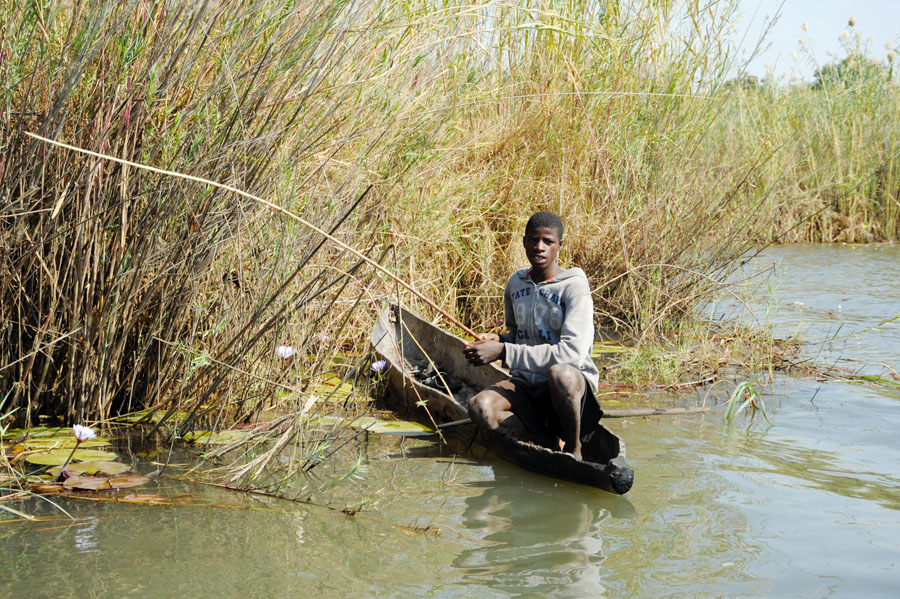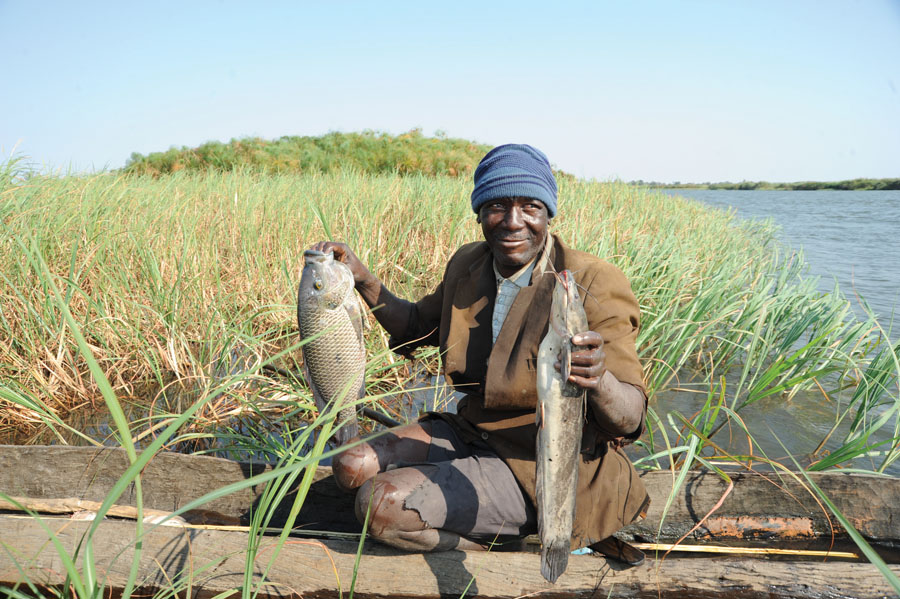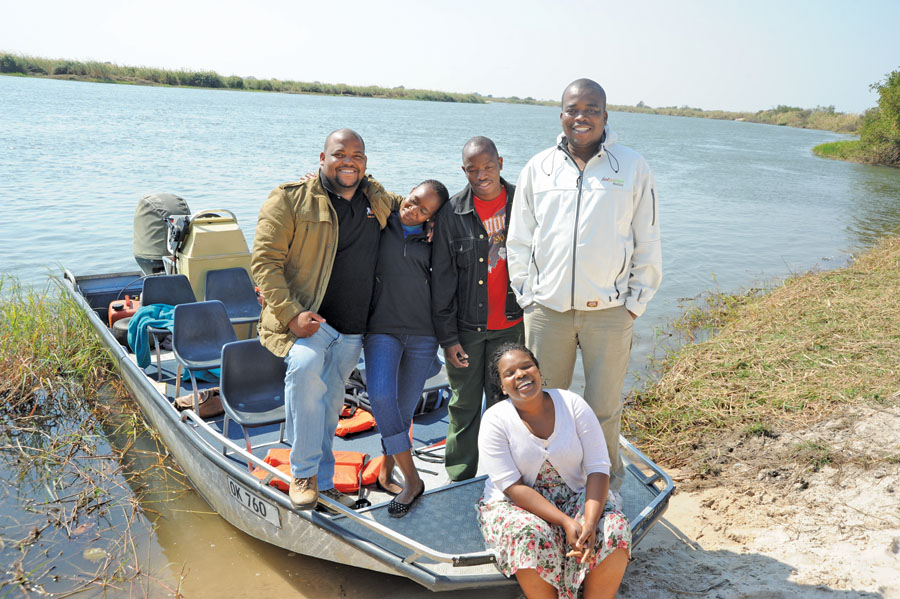Okavango fishing line odyssey
Source : Kutlwano
Author : Baleseng Batlotleng
Location : Nokaneng
Event : Interview
Deep down in the Okavango are lives and places only visible to people living in that part of the world. It does not need the wisdom of a sphinx to understand why.
Just like the Nile River in ancient Egypt which gave rise to the world`s first civilisation, people living along the Okavango River have developed a very strong attachment to this majestic waterway.
Simply put, the river defines their culture.
It was always going to be a spectacular adventure. The moment news broke that I would be taking a jaunt of the Okavango all I could do the night before was think of the sumptuous bream I was on the brink of enjoying at one of the scenic lodges along the river banks. The day finally arrived and I, together with fellow newshounds hit the road running.
After a 30 minutes drift up Komana and Toteng villages we finally arrive at a turn off in the small village of Sehithwa whose very sparse bush savanna provides us ample time to observe even up to two kilometres away where the scenery of the Lake Ngami is such a splendour. Any person you see here seems to be in no haste and stress.
The large Mokolwane trees provide a peaceful shade for those who want to chat or sell a good haul of fish from the lake or at least to those who would care to while away time imbibing a few cups of the most revered strong alcoholic beverage called motjema in this part of the world.
We travel up north until we arrive at Nokaneng village. A very interesting development takes place at the main kgotla where contrary to the usual set up both the dikgosana are women.
They tell us their tribe is made up of the Bambukushu, Bayei, Ovabanderu, Basarwa and Baherero. “morafe wa rona o itshetsa ka go lema le go rua le gone go itshetsa ka tlhapi ya noka ya Karongana ee tswang mo go yone ya Okavango. Ka dingwaga tsa bo 1969 golo fa re agileng teng fa ene ele fa noka e fetang teng. Ke sone se motse wa rona o heletseng o bitswa Nokaneng,” explains Kgosi Bahuri Segano with a tinge of Seyei accent.
Strangely in this village, no one of the Bayei people speaks the language. According to the village elders, the language has become dysfunctional, something that has never been explained.
A 32-kilometre tar drive leed us to the village of Gumare where there is not much activity taking place. Although it is normal for life to be slow for women folks than their male counterpart, here it is the other way round. We go past Etsha 6 and Etsha 13 turn-off until we arrive at Ikoga, go past Sepopa and Xhaoga.
The name Xhaoga immediately triggers memories of the deadly and infamous cattle-lung disease that ravaged the entire Ngamiland and Okavango cattle population in the late 90s.
It is normal for settlements such as Xhaoga for daily life to follow a fast paced rhythm, the community a mixture of Sesarwa and Mbukushu origins carry on with their daily routine of drying fish or pounding millet at frantic pace in a bid to beat the early winter sunset.
Wild fruits, mokutjomu and mokolwane are in season and they keep everybody busy by the riverside.
A 50-minutes drive takes us to the northwest most corner of Botswana and finally we arrive at one of the most sought after wilderness destinations affectionately known as Shake-away. The village of Shakawe prides itself as a gateway to one of the great spectacles in the world, the Okavango Delta.
The heart-stopping excitement of watching this great waterway snaking through the village of Shakawe takes our team to Mohembo West and Mohembo East, the two small communities divided by this great river.
The river starts from the Angolan highlands, crosses into Botswana at Mohembo through the Caprivi Island, then later spills over the vast, fan-shaped delta.
The timing of the floods is uncanny. Just as the waters from Botswana`s summer rains disappear between the months of April and May, so do the floodwater begin their journey of 1 300 kilometres through Kalahari sands, revitalising a vast and remarkably diverse ecosystem of plant and animal life.
We go up the village kgotla and meet Kgosi Mutemo Mbambo who gives us a brief account of the village. “Shakawe go tewa setlhare se seneng se dirisiwa ke batsumi e le sa lesego se dirisiwa thata ke morafe wa sesarwa ba eleng bone the first people, the San.
The tree is extinct now but some herbs are reportedly found in some parts of the San communities living around here. The Basarwa came from Xanekwe from the Xeregu tribe in Namibia and came to settle in Shakawe,” says Kgosi Mbambo.
We begin our journey along the Okavango River by boarding the Blue Boat operated by Drotsky`s Cabins, a popular lodge near Samochima village which lies on the western pan handle of the Okavango Delta.
After an overnight stay in luxuriously framed chalets overlooking the wide river we are now on board with our tour guide, Salvation Kanxawa, who boasts an unbeatable knowledge of the flora and fauna.
He drives at full swing, traverses the meandering palms and papyrus fringed waterways. As we brace the freezing cold breeze, Kanxawa goes further into the reed beds and crocodile infested lagoons and we stumble upon 50-year old Moyo Moyenga who has been in the waters since eight in the morning.
As we inch closer to the ferocious looking and wide agape crocodile on the river bank I am awestruck at the ease with which it allows us to enter its territory with a huge “smile”. The ageing man had only managed to haul two cat fish and a few bream.
“On a good day I can go home with at least 100 fish comprising bream and cat fish,” Moyenga explains while swaying from side to side seated in a paddle of his home made mokoro.
Then the best part of the day was when we headed home to call it a night.
The sun being swallowed by the western skies on the other side of the village while the water lilies float in their own reflections.
At this moment the fish swim downstream to sleep too, slapping their tails against the thick papyrus reeds in the river. Apparently I am told that this slapping disorientates smaller fish and they become easy prey.
As I observe this, a fully grown African fish eagle flies past signaling its early retirement to its nest. We also take our nests and allow other nocturnal creatures to enjoy the lush vegetation of the river. Ends















